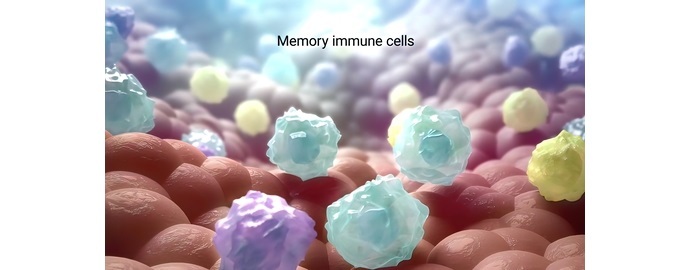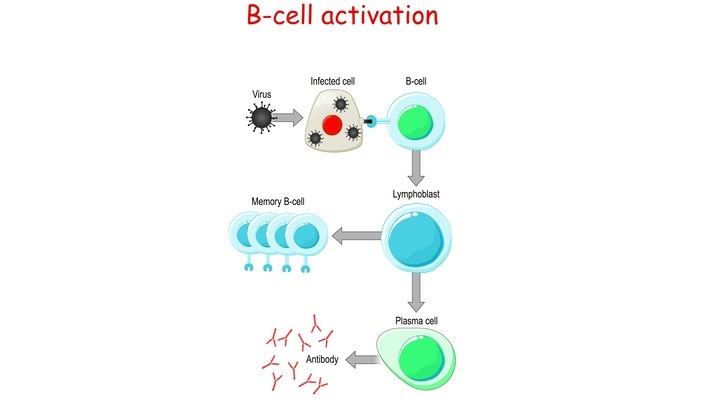
 Data Structure
Data Structure Networking
Networking RDBMS
RDBMS Operating System
Operating System Java
Java MS Excel
MS Excel iOS
iOS HTML
HTML CSS
CSS Android
Android Python
Python C Programming
C Programming C++
C++ C#
C# MongoDB
MongoDB MySQL
MySQL Javascript
Javascript PHP
PHP
- Selected Reading
- UPSC IAS Exams Notes
- Developer's Best Practices
- Questions and Answers
- Effective Resume Writing
- HR Interview Questions
- Computer Glossary
- Who is Who
Similarities and Differences between Memory T Cells and Memory B Cells
Introduction
Memory cells are long-lived immune cells capable of recognizing foreign particles that they had encountered previously. Memory cells capture the antigen or components of foreign antigen that invades our body and provides protection against them very fast when compared to the initial attack. Antigen exposure and its immune response usually 2 types
Initial Exposure - Primary immune response, here the memory does not take part in providing an immune response.
Secondary Exposure (when a similar kind or same antigen attacks the immune system) - Here memory cells start initiating the secondary immune response
Here the time taken for secondary immune response will be less when compared to the primary response as the memory cells present in the immune system has previous knowledge of the encountered antigens.
The primary immune response is usually cell-mediated immunity and the secondary immune response is humoral or antibody-mediated immunity where the antibodies attack the antigen and remove it.
The production of these antibodies by B cells requires an interaction of T cells, macrophages, dendritic cells, etc. which helps in the activation of B cells. Upon the activation, B cells are converted to plasma cells which are actually involved in the production of antibodies.

Mechanism Involved in the Generation of Memory Cells
MHC II plays a key role in initiating the adaptive immune system by alerting the immune system to an infection. When an antigen is presented on MHC II of dendritic cells, it results in an adaptive immune response to viral infections. MHC II is normally present in different cells of an immune system like dendritic cells

When a viral infection has occurred, the virus or its components which are circulating in the blood are engulfed by the dendritic cells. Now the cytoplasm of the dendritic cell has viral components, it loads the viral antigen onto the MHC class II molecules and presents them.
Since the dendritic cell is actually not infected, the immune system does not kill these cells rather the viral antigens on MHC II lead to the activation of CD4 T helper cells. These cells have T cell receptors or TCRs specific to the viral antigen presented.
Upon activation these CD4 TH cells interact with the CD8 cytotoxic T cells specific to these viral antigens as well as B cells specific to the antigen which causes them to proliferate. CD4 TH cells secrete chemical messengers that cause these CD8 Tc cells and B cells to make many clones of themselves resulting in the vast proliferation of cells specific to these viral infections.
While many cells die when the infection is subsided, some of these cells remain as memory T cells and memory B cells. Thus it is antigen presentation on MHC II that induces the immune response necessary to generate immunological memory so that disease or infection does not occur upon future exposure to the same virus.
How B Memory Cells and T Memory Cells Differ in Their Function
T cells produce much long-lasting memory than that B cells which produce only a short span of memory.
B Cell Memory
Usually, the macrophages or dendritic cells which are the antigen-presenting cells engulf the circulating antigen and present the antigen on their MHC molecules. Then the T helper cells interact with these antigens and signal/activate the effector B cells to get converted to plasma cells and produce antibodies specific to these antigens.
These antibodies eliminate the antigens by neutralization, opsonization methods, or by forming pores in a bacterial cell wall and later get degraded once the work is done. Some of the B cells remain as memory B cells which have knowledge of both antigens and antibodies.
This knowledge helps in future encounters with similar antigens. Memory B cells have a longer life span than plasma cells and they express the same membrane-bound antibody as a parent B cell.

T Cell Memory
T cells are usually activating the other cells of an immune system during an antigen exposure hence these are termed as effector T cells. Initial T cells produced are known as naïve T cells. So when these naïve T cells encounter the antigen presented on MHC II molecules of antigen-presenting cells like dendritic cells, this interaction triggers the release of many factors like IL2. So dendritic cells here train the T cell to get converted to effector T cells.
These effector T cells enable the cell-mediated immunity to contact with the adaptive humoral-mediated immunity as one alone cannot eliminate the antigen. Once the T cells' job is done, these are degraded. These effector T cells release IL2R (IL2 receptors), some of the variety effector T cells have more IL2R and some will have less IL2R.
Those T cells with less number of IL2 receptors and involved in weak interleukin signaling become memory T cells and T cells with strong IL signaling with more IL2 receptors remain as effector T cells which interact with other cells again for cell-mediated immunity. These memory T cells are long-lasting than the memory B cells.
IL7 Directs the Memory T Cell
Naive T cells have high levels of IL7 and low expressions of IL2R. IL7 induces survival and naïve cells are converted to effector T cells with antigen stimulation. During acute events, these effector T cells have slightly decreased expression of IL7R and increased of IL2R expression.
At this stage, the cytokines released induce proliferation, differentiation, and survival. Once the antigen is removed, only some T cells are remained as the memory T cells by maintaining the IL7R expression. IL7 induces survival and homeostatic turnover.
Markers of The Memory T cells
Memory cells are differentiated from the effector T cells with the help of CD45 which is expressed by a variety of cells. CD45 is also expressed in naïve, effector, and memory T cells but has a different appearance as below.
CD45 RA - It has all of its subunits, found in naive T cells.
CD45 RO- Here some subunits are cut out, found in effector or memory T cells.
Types of Memory T Cells
Memory T cells are again divided into2 types, central memory T cells and effector memory T cells. Central memory cells have no other functions except for recognizing the specific antigens and these are present in lymphoid tissue whereas effector memory T cells have higher functionality and are circulated in the body. Central memory T cells are long-lived than the effector memory T cells.
Conclusion
Memory T cells and memory B cells maintain the information pool which helps when there is a second encounter with the same or similar antigens. So as the memory T cells are more long-lasting than the B memory cells, this help to activate the other immune system cells in order to mediate the adaptive antibody-mediated immune response.
The goal of vaccines is to produce immunological memory without causing any disease. Therefore, the strongest response a vaccine can generate is a response that leads to antigen presentation on MHC II molecules to initiate the immune response that will produce memory T and memory B cells.

